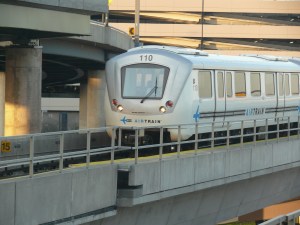Amid Christie and Cuomo Raids, Port Authority Plans Huge Fare and Toll Hike

Crossing the Hudson River will get much more expensive under a proposed Port Authority plan to sharply increase tolls and fares on its four bridges, two tunnels and the PATH train. The increases are a result of the poor economy, the costs of rebuilding after the attacks of September 11, and the expensive repairs needed on the agency’s aging infrastructure, said the Port Authority. Left unstated was the enormous cost of raids on the agency by the state governments of New York and New Jersey.
Under the Port Authority proposal, the cost to drive a car across a bridge or tunnel would increase by $4 this September, with another $2 increase in 2014. Tolls will increase the most on the costliest users. By 2014, the peak E-ZPass toll would be increased by 75 percent. Off-peak tolls would be doubled.
Truck tolls will nearly double during most times of day, reflecting the exponentially greater wear and tear inflicted by heavier vehicles. The Port Authority also hopes to disincentivize cash payments by tacking on a $3 surcharge, rising to $5 in 2014, for those who haven’t switched to E-ZPass.
PATH riders will also be forced to pay. The base fare will rise from $1.75 to $2.75; with discounts, the average fare will increase from $1.30 to $2.00 per trip. PATH riders will be spared from additional fare hikes in 2014.
To sell the toll package, which needs approval from both Governor Andrew Cuomo and Governor Chris Christie and is sure to be a heavy political lift, the Port Authority is broadcasting both its record of fiscal responsibility under popular but politically threatened executive director Chris Ward and the necessity of the projects the toll increases would fund.
The agency’s operating budget has been flat for three years, they said, while the capital budget has already been cut by $5 billion. That comes even as the costs of rebuilding at the World Trade Center have topped $11 billion and extra security requirements have added another $6 billion to the agency’s costs. The proposed toll increases, including those scheduled for 2014, would raise roughly $1 billion, according to the New York Times.
But Christie and Cuomo also bear responsibility for the Port Authority’s budget.
“Instead of finding new and steady revenue streams to pay for growing transportation infrastructure needs in each state, both Governors want to use the Port Authority as a piggy bank,” said Tri-State Transportation Campaign Executive Director Kate Slevin in a statement. “Governor Christie is relying on the Port to contribute $1.8 billion to pay for road and bridge projects that should be paid for by the state’s bankrupt transportation capital program… Governor Cuomo is banking on $380 million in Port Authority funds to help pay for the remaining three years (2012-2014) of the MTA’s capital program.”
Continued Slevin, “New Jersey has its hand in the Port Authority’s right pocket, and New York is ready to take from its left. The result is this proposal.”
That’s over $2 billion that the governors have already grabbed from the Port Authority. Because the Port Authority receives no state or local tax revenues, the $2 billion must be made up for in the toll and fare hikes.
Instead of looking like villains, however, Christie and Cuomo may be setting themselves up to look like heroes. According to the Wall Street Journal, the toll hikes proposed are much larger than what the Port Authority had been considering last year, perhaps so that the governors can ride in to the rescue and bring the toll hike down to a $2 increase.
Even so, many say that the toll increases are a necessity in order to pay for needed infrastructure. Billion dollar repairs are needed on the George Washington Bridge and the Lincoln Tunnel Helix, while major projects like raising the Bayonne Bridge to allow larger ships into Port Newark and building a bus garage adjacent to the Midtown bus terminal may also cost ten figures. Said Kathy Wylde of the business group the Partnership for New York City, “No one likes higher tolls, but without them, key infrastructure projects will come to an abrupt stop.”
